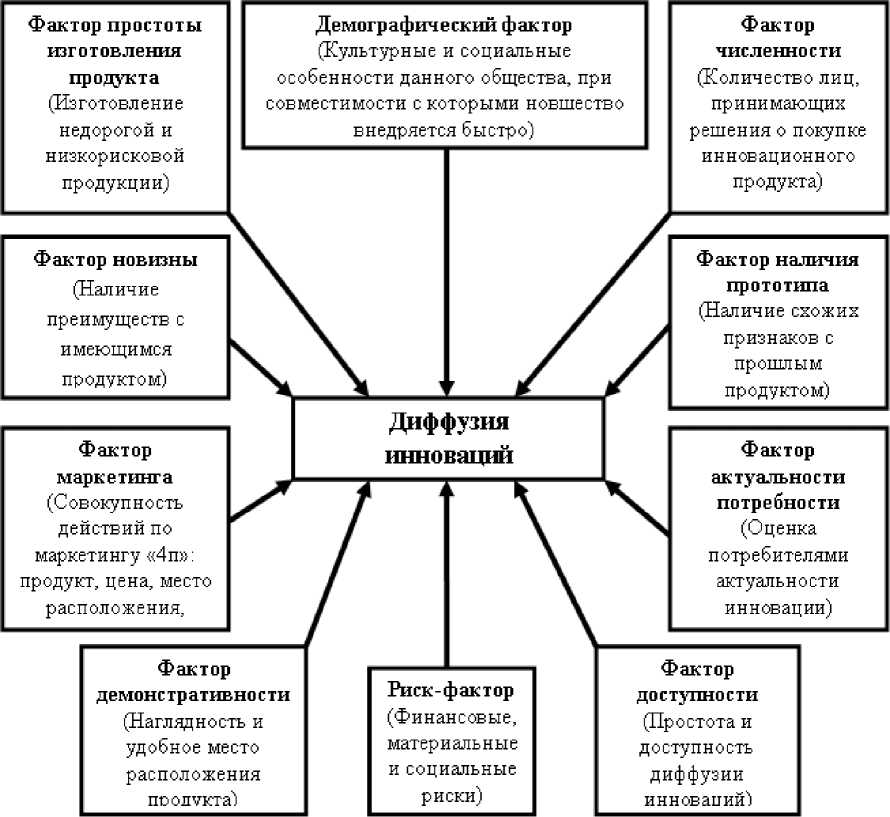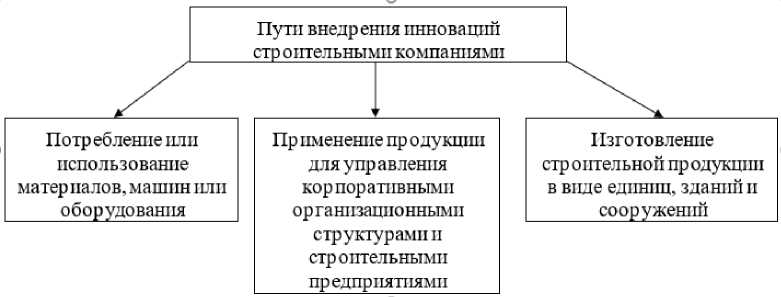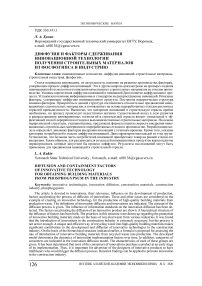Диффузия и факторы сдерживания инновационной технологии получения строительных материалов из фосфогипса в индустрию
Автор: Кукин Л.А.
Журнал: Вестник Алтайской академии экономики и права @vestnik-aael
Рубрика: Экономические науки
Статья в выпуске: 12-1, 2020 года.
Бесплатный доступ
Статья посвящена инновациям, их актуальности, влиянию на развитие производства, факторам, ускоряющим процесс диффузии инноваций. Эти и другие вопросы рассмотрены на примере создания инновационной технологии изготовления качественных строительных материалов из отходов производства. Указаны определения диффузии инноваций и инноваций Дано понятие диффузионного процесса. Установлено влияние информационных стандартов на распространение инноваций. Показаны факторы, ускоряющие диффузию инновационного продукта. Построена иерархическая структура влияния факторов. Приоритеты в данной структуре составлялись относительно продвижения инновационных строительных материалов, изготовленных на основе переработанных отходов различных отраслей промышленности. Выяснено, что внедрение инноваций в строительную отрасль крайне необходимо, но процесс происходит недостаточно активно. Существенный вклад в дело развития и распространения инновационных технологий в строительной отрасли вносит уникальный и эффективный способ переработки отходов в высококачественные строительные материалы. На основе иерархической структуры, указанной ранее, предложена формула оценки скорости внедрения инновационных строительных материалов из переработанных отходов в производство. Разработанная модель определяет динамику факторов внедрения инноваций с течением времени. Кроме того, указаны категории потребителей в модели диффузии инноваций. Дана характеристика каждой из этих групп. Установлено, что большая часть потребителей инноваций приобретают товар на ранней стадии его внедрения. Таким образом, для рекламодателя создателей инновационных продуктов важно наличие первопроходцев, которые запустили бы процесс диффузии. Результаты исследований могут быть применены для продвижения инноваций в строительной отрасли.
Инновационные технологии, диффузия инноваций, строительные материалы, строительная индустрия, фосфогипс
Короткий адрес: https://sciup.org/142225143
IDR: 142225143 | УДК: 330.341.1 | DOI: 10.17513/vaael.1484
Текст научной статьи Диффузия и факторы сдерживания инновационной технологии получения строительных материалов из фосфогипса в индустрию
В последние годы модели диффузии инноваций и их приложения все чаще изучаются в связи с быстрым развитием технологий [1]. Диффузия инновации (diffusion of innovation) – это процесс, в результате которого нововведения транспортируются по коммуникационным каналам потребителей во времени. Инновации (нововведения) могут кардинально отличаться друг от друга. Например – это могут быть как идеи, так и предметы, технологии, материалы и т.п., ставшие новым для определенного соответствующего направленности хозяйствующего субъекта [2]. Управление знаниями основ технологий влияют на управление отношений с клиентами и, соответственно, на инновационные возможности [3]. Инновации влияют на взаимосвязь организационной культуры, предпринимательской ориентации и производительности крупных производственных фирм. Предпринимательская ориентация существенно влияет на эффективность работы крупных производственных фирм. Другие факторы, такие как организационная культура, не имеют существенного отношения к производительности производственной фирмы. Фактор инноваций в значительной степени опосредовал взаимосвязь между организационной культурой, предпринимательской ориентацией и эффективностью фирмы. Механизм, используемый для повышения инновационной культуры в организации, также будет способствовать внедрению, принятию и распространению инноваций. Кроме того, эти факторы будут способствовать повышению эффективности и достижений в ближайшем будущем [4]. Другими словами, диффузия – это воплощение или уже ранее освоенной и внедренной инновации в настоящих условиях или местах внедрения. По результатам диффузии инноваций возрастает число как производителей, так и потребителей [2,5].
Цель исследования – оценка и установление зависимости скорости внедрения инноваций в производство от таких факторов как фактора демонстративности, фактора простоты изготовления продукта, фактора новизны, фактора маркетинга, фактора актуальности потребности, фактора численности, фактора доступности, риск-фактора, фактора наличия прототипа, демографического фактора, и время воздействия этих факторов.
Материал и методы исследования
Для решения поставленных задач согласно цели исследования применялись аналитические методы установления зависимости скорости диффузий инноваций на примере разрабатываемой инновационной безобжиговой технологии получения строительных материалов и изделий с одновременным выделением редкоземельных металлов из фосфогипса – отхода химического производства.
Результаты исследования и их обсуждение
Диффузионный процесс – это процесс внедрения инновации на рынке в различные хозяйствующие отрасли. Внедрение – это приобретение технологий, продуктов на рынке с различной степенью прохождения определенных стадий и регулярности [2,6]. Распространению инноваций могут способствовать стандарты на информацию о продукции. Компании, предоставляющие программное обеспечение для моделирования зданий, должны играть ключевую роль в обмене информацией о продуктах и распространении инновационных продуктов. Это обусловлено опосредованной рынком взаимозависимостью между производителями вентиляционных продуктов, компаниями-разработчиками программного обеспечения и фирмами инженерных услуг, которые могут создавать сетевые эффекты [7]. Диффузия также может изучаться как непрерывный процесс внедрения инновации на рынке на различных стадиях внедрения во времени среди участников необходимой группы с помощью коммуникаций [2,6].
Процесс диффузии инноваций является важным компонентом для того, чтобы строительные компании оставались конкурентоспособными в сегодняшней изменяющейся бизнес-среде [8].
Диффузия проходит вне зависимости от типа продукта и социальной группы потребителей. Этот процесс проходит в длительном временном промежутке по заданному образцу в несколько этапов: от низкого роста, до быстрого роста и этап спада – замедленного роста [9].
Процесс диффузии – этап, начинающийся от внедрения продукта на рынок, до насыщения рыночного сегмента и может продолжаться от нескольких дней или недель до нескольких лет. Новаторы нуждаются в быстром внедрении своей инновации, в том числе с целью опережения аналогичных конкурирующих продуктов, технологий и процессов [10,11].
К факторам, влияющим на скорость внедрения диффузионного процесса, представленным на рисунке 1, относятся следующие факторы.
-
1. Демографический фактор. Новое поколение молодых, амбициозных и наукоемких потребителей решительно принимают перемены в любых сферах жизни в целом и инновации в том числе.
-
2. Количество лиц, принимающих решения о покупке. Так, прослеживается цепочка зависимости скорости принятия решения и внедрении чего-то нового. Чем меньше
-
3. Маркетинг. Скорость внедрения инновации напрямую зависит от маркетинга, от проработанности комплекса 4Р (product (продукт), price (цена), place (место-распространение), promotion (продвижение). Совокупность действий по маркетингу продвижения складывает мнение о компании и ускоряют процесс распространения внедрения инновации [10,12].

Рис. 1. Факторы, ускоряющие диффузию инновационного продукта
-
4. Актуальность потребности. Актуальность инновации и её круг внедрения ускоряют процесс диффузии. В том случае если потребители не оценивают инновацию как актуальную, то процесс диффузии затягивается, а зачастую и в принципе теряется необходимость в таком новшестве. Так, например, многие строительные разработки зачастую не поставляются на рынок ввиду отсутствия информации об инновации у потребителя, тем самым не вызывают доверие у оконечного потребителя, что приводит к замедлению процесса диффузии.
-
5. Наличие схожих признаков с прошлым продуктом. Схожий со старым инновационный продукт, вызывает доверие у потребителя и ускоряет процесс адаптации и диффузии продукта.
-
6. Преимущество перед имеющимся продуктом, технологией. Чем больше выделяется преимуществ у инновации в сравнении с предыдущим решением, тем выше скорость апробации и диффузии [13].
-
7. Простота и доступность. Чем проще и доступнее в понимании, применении инновация для потребителя, тем быстрее происходит процесс диффузии. Производители строительных материалов стремятся доводить до конечного потребителя информацию об инновации путем создания демонстрационных видеороликов в интернет-ре-сурсах и телевидении с целью демонстрации наглядных преимуществ инновации перед имеющимися продуктами [14].
-
8. Демонстративность. Чем нагляднее выглядит продукт, а также его месторасположение на торговых площадях у продавцов, тем быстрее протекает процесс диффузии. Именно поэтому ритейлеры и крупные торговые сети стремятся выставить инновации на самом видном месте, чтобы потребитель смог увидеть то, что ему хотят продать [15].
-
9. Испытуемость. Чем проще изготовить недорогой или низкорисковый продукт инновации, тем быстрее проходит его диффузия. К примеру диффузия добавки к строительным материалам протекает быстрее, чем диффузия строительной технологии,
-
10. Риск-фактор. Чем сильнее потребитель связывает инновацию и ее диффузию с риском, тем медленнее происходит процесс диффузии. Риск-факторы могут быть разные: финансовый, материальный или социальный [18,19].
лиц участвует в процессе принятия решения, тем быстрее решение принимается. Коллегиальный характер принятия решения замедляет диффузию. Следовательно, инновация, подразумевающая коллективную работу, внедряется медленнее той, что затрагивает работу преимущественно одного индивидуума.
так как строительная добавка проще в апробации и дешевле, не требует трудоемких затрат на апробацию [16,17].
Инновации в области строительных материалов. Стоит сказать, что инновации испытывают затруднения при внедрении в отрасль строительства. Это связано с разнообразием и широким охватом последней. Не все глобальные открытия как, например, инструменты виртуального проектирования, рентабельно использовать для всех строительных единиц.
В области строительных материалов эта проблема так же актуальна. Помимо этого, с эксплуатацией инновационных строительных материалов связано множество рисков, например, необходима будет особая квалификация рабочих. Отчасти, эту проблему решает переработка различных отходов в строительные материалы. Перерабатывают всё: ТБО, отходы промышленности, остатки вышедших из эксплуатации и, как следствие, разрушенных зданий и сооружений [20-22]. Этой теме посвящено множество научных статей и трудов [23-25]. Известны способы переработки пластмассовых и резиновых отходов [26-28], опилок, скорлупы арахиса, костей, битого стекла, кофейных отходов и множества других вещей [29, 30].
Инновации в области строительства являются жизненно необходимыми. Стимулирование их возникновения может способствовать решению ряда проблем: от социальных до политических, а также достижению целей в рамках программ и проектов (рис. 2).
Указанные ранее факторы проранжиро-ваны по степени значимости относительно инновационных строительных материалов, изготовленных из отходов промышленности. Скорость внедрения таких инноваций в производство предлагается оценить следующей зависимостью:
V = FДемонстр – FПИ – FН – FМ – FА – FЧ – FДост – FР – FНП – FДемогр t10 – t9 – t8 – t7 – t6 – t5 – t4 – t3 – t2 – t1
где F – величина воздействия фактора на внедрение инноваций: FДемонстр – фактора демонстративности, FПИ – фактора простоты изготовления продукта, FН – фактора новиз- ны, FМ – фактора маркетинга, FА – фактора актуальности потребности, FЧ – фактора численности, FДост – фактора доступности, FР – Риск-фактора, FНП – фактора наличия прототипа, FДемогр – демографического фактора, а t10, t9, t8, t7, t6, t5, t4, t3, t2, t1 – время воздействия этих факторов.
Категории потребителей в диффузии инноваций.
Принято различать 5 групп по времени внедрения инноваций: инноваторы (innovators), ранние освоители (early adopters), раннее большинство (early majority), позднее большинство (late majority), запаздывающие (laggards) [2,31,32].
Инноваторы (innovators) – это первые покупатели нового продукта – те, что находятся в пределах двух стандартных отклонений от средней величины времени покупки [33].
Ранние освоители (early adopters) – следующая за инноваторами группа потребителей; они находятся в промежутке между стандартным отклонением от среднего времени покупки инновации и составляют 13,5% от всех покупателей [33,34].
Раннее большинство (early majority) – группа покупателей, следующая за ранними освоителями, составляющая не более 34% всех покупателей и занимающая промежуток между временем покупки инновации и одним стандартным отклонением.
Позднее большинство (late majority) – группа потребителей, приобретающих товар после апробации и составляет приблизительно 34% [33,35].
Близкие и знакомые – это основные источники получения информации. Они больше всех склонны быть догматиками и направлены на прошлое. Инновации внедряются и приживаются только с сопротивлением.
Так, что продуктная инновация, внедряемая на рынке, должна окупаться за определенное время. То есть затраты, понесенные на создание, производство и рекламу нового товара, должны вернуться поставщику с прибылью. Финансовый успех инновации возможен только в случае, если ее будет приобретать большинство потребителей 68% – группы раннего и позднего большинства. Для рекламодателя значит, что диффузия инновации часто требует нахождения первопроходца, который покажет пример остальным потребителям и запустит процесс диффузии [33,36].
Распространение инноваторами и ранними освоителями своих знаний и опыта использования продукта на группы большинства потребителей позволяет маркете-ру увеличить шансы диффузии инновации на успех [33,37].
Выводы
Представленные в статье факторы, влияющие на диффузию инноваций в строительстве, являются актуальными для данного вида исследования. Принимая во внимание данную теорию на практике можно существенно повлиять на процессы внедрения, экономии, а также улучшение стоимостных и технических характеристик продуктов, товаров и изделий, а также значительно снизить угрозообразующие риски применения новейших технологий и продуктов.

Рис. 2. Пути внедрения инноваций строительными компаниями
Список литературы Диффузия и факторы сдерживания инновационной технологии получения строительных материалов из фосфогипса в индустрию
- Dhakal T., Min K.-S., Lim D.-E. Review of multi-generation innovation diffusion models // Industrial Engineering and Management Systems. 2019. Vol. 18. № 4. Р. 794-807.
- Ковынева Л.В. Инновации в социально-культурном сервисе и туризме. Конспект лекций. М.; Хабаровск: Изд-во ДВГУПС, 2007. 103 с.
- Migdadi M.M. Knowledge management, customer relationship management and innovation capabilities // Journal of Business and Industrial Marketing. 2020.
- Khan W.A., Hassan R.A., Arshad M.Z., Arshad M.A., Kashif U., Aslam F., Wafa S.A. The effect of entrepreneurial orientation and organisational culture on firm performance: The mediating role of innovation // International Journal of Innovation, Creativity and Change. 2020. Vol. 13. № 3. P. 652-677.
- Корницкая О.В., Околелова Э.Ю., Трухина Н.И. Развитие инноваций и механизм их распространения на предприятиях стройиндустрии // Управление экономическими системами: электронный научный журнал. 2013. № 12. 60 с.
- Rashad A.M. Potential use of phosphogypsum in alkali-activated fly ash under the effects of elevated temperatures and thermal shock cycles // Journal of cleaner production. 2015. Vol. 87. № 1. P. 717-725
- Atkin B., Bahrami S., Landin A. Innovation diffusion through standardization: A study of building ventilation products // Journal of Engineering and Technology Management - JET-M. 2019. Vol. 54. P. 56-66.
- Wipulanusat W. Panuwatwanich K., Stewart R.A., Sunkpho J. Innovation diffusion process in the Australian construction industry. IOP Conference Series: Materials Science and Engineering. 2019. Vol. 652. № 1. Номер статьи 12001.
- Liu L., Zhang Y., Tan K. Cementitious binder of phosphogypsum and other materials // Advances in cement research. 2015. Vol. 27. P. 567-570.
- Алешина И.В. Поведение потребителей: учебник. М.: Экономистъ, 2006. 525 с.
- Hua S., Wang K., Yao X. Effects of fibers on mechanical properties and freeze-thaw resistance of phosphogypsum-slag based cementitious materials // Construction and building materials. 2016. Vol. 121. P. 290-299.
- Yoon S., Mun K., Hyung W. Physical Properties of Activated Slag Concrete Using Phosphogypsum and Waste Lime as an Activator // Journal of asian architecture and building engineering. 2015. Vol. 14. № 1. P. 189-195.
- Liu D.-S., Wang C.-Q., Mei X.-D., Zhang C. An effective treatment method for phosphogypsum // Environmental Science and Pollution Research. 2019. Vol. 26. № 29. P. 30533-30539.
- Zhou J., Li X., Zhao Y., Shu Z., Wang Y., Zhang Y., Shen X. Preparation of paper-free and fiber-free plasterboard with high strength using phosphogypsum // Construction and Building Materials. 2020. Vol. 243. Номер статьи 118091.
- Rakhila Y., Mestari A., Azmi S., Elmchaouri A. Elaboration and characterization of new ceramic material from clay and phosphogypsum // Rasayan Journal of Chemistry. 2018. Vol. 11. № 4. P. 1552-1563.
- Gu K., Chen B. Loess stabilization using cement, waste phosphogypsum, fly ash and quicklime for self-compacting rammed earth construction // Construction and Building Materials. 2020. Vol. 231. Номер статьи 117195.
- Cheremisina O., Sergeev V., Fedorov A., Alferova D., Lukyantseva E. Recovery of rare earth metals from phosphogypsum-apatite ore sulfuric acid leaching product. International Multidisciplinary Scientific GeoConference Surveying Geology and Mining Ecology Management, SGEM. 2019. Vol. 19. № 1.3. P. 903-910.
- Podolyanets L.A. Economical assessment of comprehensive mineral processing of phosphogypsum with rare earth elements' extraction // Opcion. 2018. Vol. 34. № 85. P. 1491-1508.
- Туболкин А.Ф. Производство без отходов. Л.: Знание. 1980. 32 с.
- Dinis F.M., Sanhudo L., Martins J.P., Ramos N.M.M. Improving project communication in the architecture, engineering and construction industry: Coupling virtual reality and laser scanning // Journal of Building Engineering. 2020. Vol. 30. Номер статьи 101287.
- Kazmi D., Williams D.J., Serati M. Waste glass in civil engineering applications - A review // International Journal of Applied Ceramic Technology. 2020. Vol. 17. № 2. P. 529-554.
- Liu D.-S., Wang C.-Q., Mei X.-D., Zhang C. An effective treatment method for phosphogypsum // Environmental Science and Pollution Research. 2019. Vol. 26. № 29. P. 30533-30539.
- Saeli M., Piccirillo C., Tobaldi D.M., Binions R., Castro P.M.L., Pullar R.C. A sustainable replacement for TiO2 in photocatalyst construction materials: Hydroxyapatite-based photocatalytic additives, made from the valorisation of food wastes of marine origin // Journal of Cleaner Production. 2018. Vol. 193. P. 115-127.
- Faraj R.H., Hama Ali H.F., Sherwani A.F.H., Hassan B.R., Karim H. Use of recycled plastic in self-compacting concrete: A comprehensive review on fresh and mechanical properties // Journal of Building Engineering. 2020. Vol. 30. Номер статьи 101283.
- Awoyera P.O., Adesina A. Plastic wastes to construction products: Status, limitations and future perspective // Case Studies in Construction Materials. 2020. Vol. 12. Номер статьи e00300
- Chew J., Poovaneshvaran S., Mohd Hasan M.R., Hamzah M.O., Valentin J., Sani A. Microscopic analysis and mechanical properties of Recycled Paper Mill Sludge modified asphalt mixture using granite and limestone aggregates // Construction and Building Materials. 2020. Vol. 243. Номер статьи 118172.
- Rashad A.M. Phosphogypsum as a construction material // Journal of Cleaner Production. 2017. Vol. 166. P. 732-743.
- Vinod Kumar V., Ghorpade V.G., Sudarsana Rao H. Comparative study of recycled building material waste, copper slag waste and egg shell waste as a partial replacement for sand in cement blocks // Journal of Advanced Research in Dynamical and Control Systems. 2019. Vol. 11. № 10. P. 559-566.
- Fuchigami Y., Kojiro K., Furuta Y. Quantification of greenhouse gas emissions from wood-plastic recycled composite (WPRC) and verification of the effect of reducing emissions through multiple recycling. Sustainability (Switzerland). 2020. Vol. 12. № 6. Номер статьи 2449.
- Zou, S. Li, H. Wang, S. Jiang, R. Zou, J. Zhang, X. Liu, L. Zhang, G. / Experimental research on an innovative sawdust biomass-based insulation material for buildings // Journal of Cleaner Production. Vol. 260. 1 July 2020. Номер статьи 121029.
- Волженский А.В. Минеральные вяжущие вещества: учеб. пособие для вузов. М.: Стройиздат, 1986. 464 с.
- Терехов А.В. Искусственный гипсовый камень из активированного // Строительные материалы. 1985. № 2. С. 22-24.
- Дубровин, И.А. Поведение потребителей: учебное пособие М.: Издательско-торговая корпорация "Дашков и Ко", 2012. 312 с.
- Потапов Ю.Б. Процессы структурообразования и технология получения безобжиговых вяжущих на основе фосфогипса дигидрата // Строительные материалы. 2003. № 7. С. 37-39.
- Зуев М.В., Мамаев С.А., Михеенков М.А., Степанов А.И. Композиционное водостойкое гипсовое вяжущее // Патент РФ №2505504. Заявитель и патентообладатель Общество с ограниченной ответственностью "ЭВЕРЕСТ". №201212993/03. МПК C04B28/14, C04B7/14. заявлено 13.07.2012; опубл. 27.01.2014. Бюл. № 3. - 2 с.
- Zolotukhin S.N., Kukina O.B., Barabash D.E. Structure-forming role and properties of phosphogypsum in unburned technology of wall materials and rare-earth metals concentrate simultaneous production. IOP Conf. Series: Materials Science and Engineering. 2019. Vol. 687. № 2. Номер статьи 022028.
- Zolotukhin S.N., Kukina O.B., Mishchenko V.Ya., Larionov S. Waste-free phosphogypsum processing technology when extracting rare-earth metals // Advances in Intelligent Systems and Computing. 2019. Vol. 983. P. 339-351.


